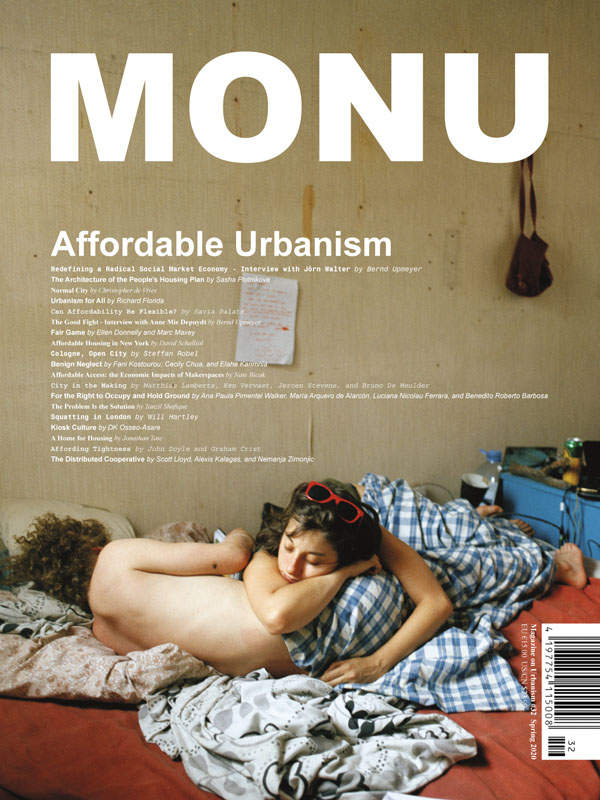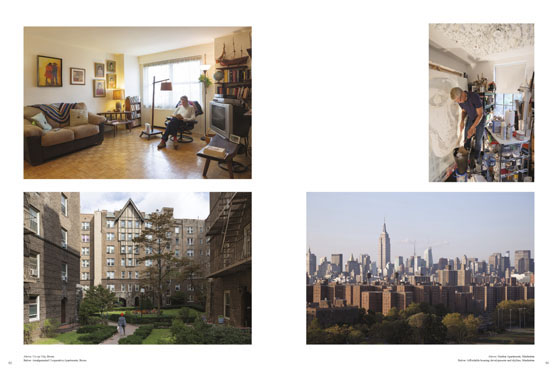MONU #32
MONU #32: Affordable UrbanismMagazine on Urbanism, April 2020Paperback | 7-3/4 x 10-1/2 inches | 128 pages | English | ISSN: 1860-3211 | $23.99 ISSUE CONTENTS: Redefining a Radical Social Market Economy - Interview with Jörn Walter by Bernd Upmeyer; The Architecture of the People’s Housing Plan by Sasha Plotnikova; Normal City by Christopher de Vries; Urbanism for All by Richard Florida; Can Affordability Be Flexible? by Savia Palate; The Good Fight - Interview with Anne Mie Depuydt by Bernd Upmeyer; Fair Game by Ellen Donnelly and Marc Maxey; Affordable Housing in New York by David Schalliol; Cologne, Open City by Steffan Robel; Benign Neglect by Fani Kostourou, Cecily Chua, and Elahe Karimnia; Affordable Access: the Economic Impacts of Makerspaces by Nate Bicak; City in the Making by Matthias Lamberts, Ken Vervaet, Jeroen Stevens, and Bruno De Meulder; For the Right to Occupy and Hold Ground by Ana Paula Pimentel Walker, María Arquero de Alarcón, Luciana Nicolau Ferrara, and Benedito Roberto Barbosa; The Problem Is the Solution by Tanzil Shafique; Squatting in London by Will Hartley; Kiosk Culture by DK Osseo-Asare; A Home for Housing by Jonathan Tate; Affording Tightness by John Doyle and Graham Crist; The Distributed Cooperative by Scott Lloyd, Alexis Kalagas, and Nemanja Zimonjic REVIEW BY MARIA HEINRICH: The 32nd issue of MONU, "Affordable Urbanism," was published in April, when the Covid-19 crisis was already showing us the aftermath of deficient social housing. In some cities, it is made agonizingly clear how bad housing conditions are directly linked to high infection and mortality rates. One of the contributors, Sasha Plotnikova, makes this strikingly clear: "Like an epidemic, LA’s eviction crisis hits the most vulnerable the hardest." Next to Plotnikova, the other contributions in the magazine offer a varied account on affordable housing that ranges from theoretical framework to implementations that are already in place, and in some cases are even under the threat of extinction. Privatization of land and gentrification are making ground and construction value soar while there is a polarization into a richer middle class and a poorer working class. This is causing an accelerating need for affordable housing all around the world. Solutions for these problems can be found in both top-down and bottom-up measures. These top-down measures can include policy renewals such as in Paris, Hamburg, or Zurich, where around one-quarter to one-third of newly built rental housing has to be affordable. Scott Lloyd, Alexis Kalagas, and Nemanja Zimonjic illustrate how in Zurich the involvement of housing cooperatives is decisive to achieve this goal. As the offer of large building sites is decreasing steadily, they propose a "distributed cooperative" that is built on dispersed plots. Other solutions that are implemented by cities are hereditary or emphyteutic leases where buildings are in private possession but the land underneath belongs to the city. This way the municipality has the authority to mandate the ratio of social housing on this "private property." Bottom-up efforts include land occupations, flexible DIY-spaces and informal business solutions. Melbourne-based architects John Doyle and Graham Christ point out that East Asian cities offer a wide portfolio of what they call "tight architecture." These buildings stand on small pieces of residual land and thereby adopt the whole of the city and make land cheaper because a dense city is an affordable city. This can happen by bottom-up appropriation or top-down planning. While many answers are given to how housing can be made affordable, other integral aspects of urbanism are left unsolved. Are there ways to apply these measures to public space, transportation and infrastructure in an attempt to create an affordable city? Two articles, one on the Green belt of Cologne and the other on informal kiosk culture in Ghana’s harbor town of Tema take the aspect of affordability into the public realm. Apart from that, Richard Florida’s contribution, "Urbanism for All," is a call for politicians to care more about urban policy, including infrastructure. Whereas these features shed some light on what affordable urbanism could mean, a bigger variety of urban cases would have been instructive. After reading the magazine, one is closer to understanding how to build cities that are fair because they offer affordable space to citizens of all backgrounds. While no article serves as a solution for all cases, the different contributions form a set of tools that can be applied by citizens, planners, and politicians. The varieties of precedents from neighborhoods and cities that are mentioned make it clear that the most resilient solutions are community-driven and are facilitated by local policy-makers. Because of current discussions, it will be interesting to see if affordability will play a role in the next issue of MONU, "Pandemic Urbanism." that is expected this fall.

MONU #32: Affordable Urbanism
Magazine on Urbanism, April 2020
Paperback | 7-3/4 x 10-1/2 inches | 128 pages | English | ISSN: 1860-3211 | $23.99
Inside the Issue:
ABOUT MONU:






